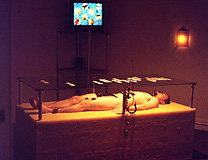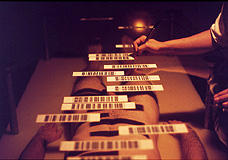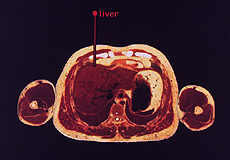ITEMS 1-2,000: A CORPUS OF KNOWLEDGE ON THE RATIONALIZED SUBJECT
by Paul Vanouse, 1996
Video Documentation
 In 1988, I finished a concentration in
pre-med studies at the State University of New York at Buffalo. By this
point, I was disenchanted and decided against the career because of
varied issues surrounding the practice of medicine, especially in the
US. These issues included the ethics of human and animal research; the
rationalization and fracturization of the body underlying western
medical understanding of the body; and the exclusive health care system
of the US which the majority of its population cannot afford.
In 1988, I finished a concentration in
pre-med studies at the State University of New York at Buffalo. By this
point, I was disenchanted and decided against the career because of
varied issues surrounding the practice of medicine, especially in the
US. These issues included the ethics of human and animal research; the
rationalization and fracturization of the body underlying western
medical understanding of the body; and the exclusive health care system
of the US which the majority of its population cannot afford.
 Items 1-2,000 collapses western
medicine's fracturization of the body with industrial itemization
techniques into the ultimate rationalization apparatus. A human body is
half submerged in a block of wax, in a manner reminiscent of how
biological specimens are fixed in a "microtome" (a machine which cuts
these wax embedded specimens into slices often as thinly as 1
millimeter.) A sheet of glass rests several inches above the figure in
a manner analogous to that of a cover slide used atop the cross
sectional slices in microscopy. This glass is affixed with barcodes,
running transversely across the glass, which correspond to internal
organ locations of the figure underneath.
Items 1-2,000 collapses western
medicine's fracturization of the body with industrial itemization
techniques into the ultimate rationalization apparatus. A human body is
half submerged in a block of wax, in a manner reminiscent of how
biological specimens are fixed in a "microtome" (a machine which cuts
these wax embedded specimens into slices often as thinly as 1
millimeter.) A sheet of glass rests several inches above the figure in
a manner analogous to that of a cover slide used atop the cross
sectional slices in microscopy. This glass is affixed with barcodes,
running transversely across the glass, which correspond to internal
organ locations of the figure underneath.
Participants
interact with the work as anatomy students would a cadaver: They use a
stainless steel barcode scanner much like a scalpel, slicing
horizontally across the figure to reveal the hidden target organ. The
more familiar use of barcodes and scanning procedures however are not
lost, and this surgical role blurs with that of cashier, commodifying
and extracting value through the denial of the body as whole (rather a
rational composite of itemized parts.) Each targeted anatomical region
has an axial, transverse and saggital center, so that once the program
accesses the correct axial slice, an arrow points to the correct x and
y location within this Cartesian corpus. Every third scan the
participant makes accesses a jarred recollection from my own
experiences as a student in the anatomy morgue. These recollections are
somewhat poetic and primarily address the phenomena of de-humanization
of the corpse as it is de-constructed and subsequently re-configured
through dissection. These musings attempt to de-construct the
rationalization processes of western bio-medical practices and to
discover a point of empathy with the subject.
 The sliced human data-set used for
Items 1 - 2,000 is exported from the National Institute of Health's
Visible Human Project. CD-ROM. This was a multi-million dollar
endeavor, in which a death-row inmate was given lethal injection, his
internal cavities filled with latex, embedded in a wax-like gelatin,
and sliced into 2,000 thin slices which were photographed and
digitized. Certainly Foucault would have found the Visible Human
project fascinating as the disciplined body of the prisoner is
subjected to the ultimate surveillant process (minute dissection) and
his body, essentially "drawn and quartered" in the ultimate spectacular
punishment.1
The sliced human data-set used for
Items 1 - 2,000 is exported from the National Institute of Health's
Visible Human Project. CD-ROM. This was a multi-million dollar
endeavor, in which a death-row inmate was given lethal injection, his
internal cavities filled with latex, embedded in a wax-like gelatin,
and sliced into 2,000 thin slices which were photographed and
digitized. Certainly Foucault would have found the Visible Human
project fascinating as the disciplined body of the prisoner is
subjected to the ultimate surveillant process (minute dissection) and
his body, essentially "drawn and quartered" in the ultimate spectacular
punishment.1
The
recollection movies I have created from varied image sources. Most of
the overlaid, diagrammatic components are taken from anatomy student
dissection manuals; other elements are scanned from my own sketchbooks
(In 1988, near the end of my pre-med studies, I would often return to
the anatomy lab after hours to make pen and ink drawings of the
corpse); while others utilize other medical data sets which I have
de-convolved using specialized bio-medical software such as Analyze,
running on Unix workstations at Pittsburgh's Science and Technology
Center. I have also used a Scanning Electron Microscope to create
certain close-ups, which are used in the final recollection movie clip.
1.
I'm referring primarilly to Foucault's Discipline and Punish text --
Michel Foucault, Discipline and Punish., 2nd ed. trans. Alan Sheridan
(Random House Inc., New York, 1994).
Back to ArtDoc
 In 1988, I finished a concentration in
pre-med studies at the State University of New York at Buffalo. By this
point, I was disenchanted and decided against the career because of
varied issues surrounding the practice of medicine, especially in the
US. These issues included the ethics of human and animal research; the
rationalization and fracturization of the body underlying western
medical understanding of the body; and the exclusive health care system
of the US which the majority of its population cannot afford.
In 1988, I finished a concentration in
pre-med studies at the State University of New York at Buffalo. By this
point, I was disenchanted and decided against the career because of
varied issues surrounding the practice of medicine, especially in the
US. These issues included the ethics of human and animal research; the
rationalization and fracturization of the body underlying western
medical understanding of the body; and the exclusive health care system
of the US which the majority of its population cannot afford.  Items 1-2,000 collapses western
medicine's fracturization of the body with industrial itemization
techniques into the ultimate rationalization apparatus. A human body is
half submerged in a block of wax, in a manner reminiscent of how
biological specimens are fixed in a "microtome" (a machine which cuts
these wax embedded specimens into slices often as thinly as 1
millimeter.) A sheet of glass rests several inches above the figure in
a manner analogous to that of a cover slide used atop the cross
sectional slices in microscopy. This glass is affixed with barcodes,
running transversely across the glass, which correspond to internal
organ locations of the figure underneath.
Items 1-2,000 collapses western
medicine's fracturization of the body with industrial itemization
techniques into the ultimate rationalization apparatus. A human body is
half submerged in a block of wax, in a manner reminiscent of how
biological specimens are fixed in a "microtome" (a machine which cuts
these wax embedded specimens into slices often as thinly as 1
millimeter.) A sheet of glass rests several inches above the figure in
a manner analogous to that of a cover slide used atop the cross
sectional slices in microscopy. This glass is affixed with barcodes,
running transversely across the glass, which correspond to internal
organ locations of the figure underneath.
 The sliced human data-set used for
Items 1 - 2,000 is exported from the National Institute of Health's
Visible Human Project. CD-ROM. This was a multi-million dollar
endeavor, in which a death-row inmate was given lethal injection, his
internal cavities filled with latex, embedded in a wax-like gelatin,
and sliced into 2,000 thin slices which were photographed and
digitized. Certainly Foucault would have found the Visible Human
project fascinating as the disciplined body of the prisoner is
subjected to the ultimate surveillant process (minute dissection) and
his body, essentially "drawn and quartered" in the ultimate spectacular
punishment.1
The sliced human data-set used for
Items 1 - 2,000 is exported from the National Institute of Health's
Visible Human Project. CD-ROM. This was a multi-million dollar
endeavor, in which a death-row inmate was given lethal injection, his
internal cavities filled with latex, embedded in a wax-like gelatin,
and sliced into 2,000 thin slices which were photographed and
digitized. Certainly Foucault would have found the Visible Human
project fascinating as the disciplined body of the prisoner is
subjected to the ultimate surveillant process (minute dissection) and
his body, essentially "drawn and quartered" in the ultimate spectacular
punishment.1